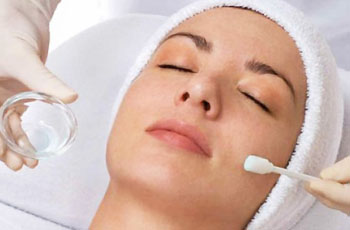
Services > chemical peeling
CHEMICAL PEEL
Chemical peeling is a technique used to improve the appearance of the skin which is typically performed on the face, neck or hands. In this treatment, a chemical solution is applied to the skin which eventually peel off in the form of dryness. The new, regenerated skin is usually smoother and less wrinkled than the old skin. The new skin is also temporarily more sensitive to the sun.
We have used various peeling agents and are experts in performing multiple types of chemical peels. A thorough evaluation is imperative before embarking upon a chemical peel.
.

WHAT CAN A CHEMICAL PEEL DO?
Chemical peeling is often used to treat fine lines under the eyes and around the mouth. Wrinkles caused by sun damage, aging and hereditary factors can often be reduced or even eliminated with this procedure.
Mild scarring and certain types of acne can also be treated with chemical peels. In addition, pigmentation of the skin in the form of sun spots, age spots, freckles, and skin that is dull in texture and color may be improved with chemical peeling.
Chemical peeling may be combined with laser resurfacing, dermabrasion or soft tissue fillers to achieve cost-effective skin rejuvenation customized to the needs of the individual patient. Areas of sun-damaged or scaling patches may improve after chemical peeling. Following treatment, new lesions or patches are less likely to appear. Generally, fair skinned and light haired patients are ideal candidates for chemical peels. Darker skin types may also experience good results, depending upon the type of skin problem encountered.
HOW ARE CHEMICAL PEELS PERFORMED?
Prior to the procedure, instructions may include the elimination of certain drugs and the preparation of the skin with topical pre-conditioning medications. The patient is advised to clean the area with an antiseptic soap the day before surgery.
A chemical peel is performed in our procedure room. At the time of treatment, the skin is thoroughly cleansed with an agent that removes excess oils, and the eyes and hair are protected. One or more chemical solutions - an alpha hydroxy acid, such as glycolic acid, salicylic acid, or lactic acid; trichloroacetic acid (TCA); or carbolic acid (phenol) - are used. We select the proper peeling agent based upon the type of skin damage present. During a chemical peel, the solution is applied to small areas on the skin. These applications produce a controlled wound, enabling new, refreshed skin to appear. Most patients experience a warm to somewhat hot sensation which lasts about five to ten minutes, followed by a stinging sensation.
WHAT SHOULD BE EXPECTED AFTER TREATMENT?
Depending upon the type of peel, a reaction similar to sunburn occurs following a chemical peel. Chemical peeling usually involves redness, followed by scaling that ends within three to seven days. It is important to avoid overexposure to the sun after a chemical peel since the new skin is fragile and more susceptible to complications. We will prescribe the proper follow-up care to reduce the tendency to develop abnormal skin color after peeling.
ARE THERE SIDE EFFECTS?
If chemical peel is done under proper guidance & post peel care is taken properly then there are very few chances of side effects. Sometimes there can be excessive dryness after the procedure. Post peeling the skin is sensitive to sun & proper sun protection should be taken to avoid darkening of the skin. In few individuals redness might last for a longer time than expected

